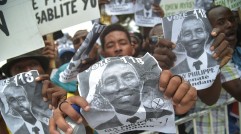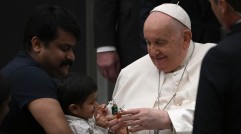Metropolitan Opera Review 2015-16: Il Trovatore : Anna Netrebko, Dmitri Hvorostovsky, Dolora Zajick, Yonghoon Lee Deliver Definitive Performances in Powerful McVicar Production
There is an old cliché about the only thing necessary to stage Verdi's "Il Trovatore" is the "four greatest singers in the world."
The Metropolitan Opera was about as close to fulfilling that requirement on Friday as it unveiled the opera for the first time in the 2015-16 season.
The performance was a showcase for two singers in particular, but there could be no doubt that all four performers in the main quartet brought fascinating insight into the roles of this very complex drama.
Most people were looking forward to seeing the Russian superstars take the stage for very different reasons. One hand there was Anna Netrebko, singing her first Leonora at the Met, a character that she has dominated in Europe. And on the other side of the bracket was the return of baritone Dmitri Hvorostovsky to the stage after months of battling a brain tumor. Safe to say that both stars were at very high levels, delivering nuanced and deeply poignant performances.
From the moment she walked on stage, Netrebko was showered with applause, her Leonora already assuming a melancholic vibe that would permeate her rendition. However, this Leonora initially seemed weak, almost dependent on the thought of not seeing Manrico again, but she eventually reversed the fortunes, transforming herself into an empowered woman who would give life to Manrico.
From an acting standpoint, her whole arc could be defined by her interactions with the set. In her opening scene, she clung to a nearby wall, a weakened stance; by Act 4's "Misere" she was actually climbing a gate. In the opening trio, she stood away from the action, unsure of how to act and in the second act concertato she was likewise reluctant to move toward Manrico, advancing slowly, then pulling back and then eventually gliding across the stage to her lover. But in the final confrontation with the Count she went right after him and did her utmost to save her Manrico.
Her singing underwent a similar arc of a character full of delicacy and lightness to one brimming with intense emotion. Verdi's music certainly does this on its own, but Netrebko added her own touches to make it a deeply personal performance.
Her singing in the opening "Tacea la Notte" had a suave legato, her voice giving off a propulsive pace as she soared on Verdi's ascending lines. There was a rough patch at the cadenza's high C (she basically missed the note) but she made up for it with an assured vocal display in the virtuosic "Di tale amor che dirsi," her coloratura flourishes quite agile and she seemed to pick up great strength and confidence from the moment.
In the final act of the opera, Leonora gets a massive scene that includes an aria that pushes the tessitura into the soprano stratosphere, a piece with chorus that pushes the voice into the valley of the soprano voice and then a caballeta with a plethora of roulades. Through this we see Leonora go from helpless and needy to hopeful and resolute. During the opening "D'amor sull'ali rosee" Netrebko's voice was delicate, a fragile thread in the upper registers that filled the theater with tension. Again, one could feel the phrasing moving in desperation and then coming to a standstill on the upper notes, Netrebko holding the peaks as Leonora held on to her love with all of her might.
But the real killer was the "Miserere" where the Russian diva showed the world how powerful and expressive her lower register could be. She punched the consonants aggressively, her voice seemingly growing stronger and stronger to the conclusion of the opening stanza. On the repetition, something wonderful happened -- Netrebko started off the phrase quietly, giving off the sense that Leonora might in fact be giving up and the final phrasing of "il respiro, i palpiti al cor" diminuendoed, showing Leonora's brief loss of willpower. She recouped it in time for the finale of the section and then launched into the ensuing recitativo "Di te! Di te! scordarmi di te!" with aplomb.
There was one other exemplary moment of Netrebko's vocal acting and it came in the duet with the Hvorostovsky. Leonora has just drunk poison to kill herself and her first lines of the duet cabaletta require some coloratura. Netrebko phrased those descending lines as if they were the very poison weakening her, each one growing softer and softer as her body slowly drooped. These are just a few of the many treats Netrebko offered on this evening, emphasizing just how much of a powerhouse artist she truly is.
Hvorostovsky was also greeted with thunderous applause upon his first appearance on stage, a showstopping moment that literally forced conductor Marco Armiliato to put down his baton and join in the clapping. From then on, the baritone did his utmost to reward the audience's admiration. There were times in past performances of this role when one would hear the Russian baritone push his voice uncomfortably through the opening act trio, but this time he was in complete control, comfortable with the heavy demands of Verdi's lines.
His approach to the role was more finessed and delicate, his Conde di Luna a regal and suave man in the early going with a propensity to lose his temper and unleash his fury; at these moments Hvorostovsky's more delicate timbre would transform into a more aggressive and coarse quality that suited Luna's polar extremes.
The aria "Il Balen del suo sorriso" is arguably the most tender piece of music in the opera as di Luna comments on how Leonora's smile could elicit the most beautiful emotions from him. He sang with silky legato, his voice lightened up to emphasize the character's sweeter side. As the aria develops, the music takes on a Verdian propulsion with di Luna's desperation and passion for Leonora growing; Hvorostovsky voice matched this intensity, his sound and power growing until he reached the cadenza. The high G was a cry of desperation, the heart of the character on full display in painful vulnerability. He finished off the aria in sotto voce phrasing, the tenderness and beauty of Hvorostovsky's voice at its most intimate. The ensuing applause was the most riveting of the night and it was rightly deserved.
As the night wore on the aggression of the character came through with greater degree of visibility and was particularly remarkable in the Act 4 duet with Leonora. Hvorostovsky grabbed Netrebko violently, almost forcing her to be his, his voice placing accents throughout that came off as sexual craving, the character giving into his animalistic desires. One could feel the tension building and as he kissed her ravenously on set, you could feel that di Luna might strip off Leonora's clothes right then and there. At the close of the night, the baritone was given the spotlight and showered with flowers and a standing ovation from the audience in loving support. It was truly a winning night for Hvorostovsky.
In the title role of Manrico was Korean tenor Yonghoon Lee. Lee has made a name for himself at the Met for his poignant Don Carlo and a riveting and violent portrayal of Don Jose in "Carmen." His Manrico was an interesting portrayal, brimming with violent potential throughout the opening acts before softening; it was almost as if he were moving in the opposite direction from Hvorostovsky's Count.
During the opening trio, Lee's Manrico attacked his notes emphatically and readily unsheathed his sword on a few instances. In the ensuing scene, his interactions with Azucena were despondent, the character almost seeming annoyed by his raving mother, the singing here equally virile. However, this was far from a one note delivery and Lee found nuance that other tenors often overlook in the role. During the famed passage in which Manrico narrates his duel with di Luna, "Mal reggendo all'aspro assalto," Lee sang rather quietly early on, pulling the listener into the narrative. As his story grew and strengthened his voice did the same and yet at the end, it lightened into a subtle whisper, setting up Azucena's violent rebuttal quite brilliantly.
He matched Hvorostovsky phrase for phrase in the Act 2 concertato, their interchanging lines coming off as vocal sparring with each passage growing in intensity. From a dramatic standpoint (and this will be highlighted below in reference to the production as a whole), Lee's most effective moment might have come at the end of his pezzo concertato when Manrico has a chance to slit his rival's throat. Lee's Manrico prepared to deliver the death blow and then suddenly looked up, as if hearing the "voice" from his head yet again. In a potent moment, he suddenly swiped at Hvorostovsky's eye, an action that clearly hurt Manrico as much as it did the Count.
In his aria "Ah si, ben mio," Lee unleashed his entire vocal arsenal, his singing delivering a sense of Manrico's pain at the thought of death. His ascent to the B flat was the result of a crescendo growing over numerous phrases. And despite his vocal power blossoming throughout the aria, the most expressive moments came at the end with Lee's voice delivering some of the most delicious diminuendo's of the night. His final "La morte a me parra" was a sliver of sound that eventually reached a sublime crescendo on the second syllable of "parra;" it was a final cry of desperation delivered by a hero displaying his weakness.
And then came the heroic "Di Quella Pira," which for better or worse, is the moment that defines most Manrico performances for audiences. Here Lee was as impressive as ever, every consonant emphasized, almost a mirror of di Luna's aggressive nature. At this moment in the night, it was clear that the two brothers had more in common than they cared to admit, something very apparent in Verdi's work that often gets overlooked in interpretation.
For the climactic high note, Lee let his voice go with all of his might and it soared all through the orchestral coda, tapering off as the orchestra's final note finished resounding. Few tenors have that courage, guile or technique to pull that off (B flat or C natural), but Lee certainly managed it.
The "Di Quella Pira" turned out to be a turning point for Lee's interpretation of the character as Manrico opts for abandoning Leonora in favor of his mother, reversing his objective from the first half of the opera. And just as his attitude toward which woman is most important in his life shifts, thus does his behavior toward his mother. In other interpretations of this production, Manrico would usually sit away from Azucena in their final scene, ignoring her. This time around Lee's Manrico actually looked to comfort her, his singing at its sweetest with connected phrasing. He still seemed almost afraid of her, but the annoyance of the opening half was not apparent.
Yet in the final confrontation with Leonora, "Parlar non vuoi" the accented lines made a return at their most aggressive and thrilling, Manrico's fury and anger at its most potent. It was a rather poignant interpretation of a character often delivered in broad strokes vocally and physically. Lee managed to remind us just how nuanced Verdi's vocal lines and drama is in the right hands.
It seems unfair to bring up Dolora Zajick so late in this review because she was just as deserving of being discussed first. Her interpretation of Azucena is undoubtedly the best of modern times, and it just seems to get better and better with age. Undeniably no longer possessing the polished voice of yesteryear, Zajick still manages to wield her instrument in ways that make Azucena come off as increasingly unstable. Her opening "Stride la vampa" was filled with jagged phrase and a propensity for sudden vicious accent expressing the character's dangerous qualities. At the final phrase of each verse, Azucena gets a lengthy trill, delineating the character's instability through chromaticism. Zajick's trill is rather wide these days, adding to the eeriness to the moment and making the character all the more frightening. It certainly added to the staging of Azucena taking out her dagger and preparing to stab an innocent child. Her constant delivery of the line "Mi vendica" had an edge to it in its quiet and yet pointed attack.
Her interactions with Manrico were fueled with overprotection and yet bearing an animosity toward him. Just listen to her "Strana pieta" in its coarse delivery (she even throws a cloth at him that she was using to treat his injury), emphasizing her disdain for his decision to save di Luna. Her singing throughout these passages was filled with accented phrasing, often threatening to overpower Lee. While they were definitely working together, there were moments where it also seemed to be a battle of vocal wills, one character trying to subjugate the other.
At the core of this scene is Azucena's narration of her evil deed and Zajick delivered her finest rendition that this writer has seen over the years. "Condotta ell'era in ceppi al suo destin tremendo" commences quietly before burning up in passion like the fire it narrates. The climax of the passage has Azucena viscerally shout "Il figlio mio" in one of the most powerful displays of Verdi's parola scenia. Zajick's cries were filled with all the painful emotion she could muster. Anguish, anger, suffering, disgust. It was all there in a visceral gut punch that is still felt at the moment of this writing. The final passage in the lower stratosphere was filled with bitterness, slowly withering away until the final utterances floated away inaudibly like the ghost of the dead child and mother in the story. It still gives this writer chills.
Azucena's final two moments of the opera could not contrast more greatly. As she battles the Count and his henchman, the music is filled with the rage we get glimpses of in "Stride la vampa," and this time Zajick relished it wondrously, her pointed phrasing rising over the chorus and orchestra. In the final scene in the prison, the character's own violent will seems defeated, her hopes of retribution lost. As she sang "Ai nostri monti ritorneremo," her singing found a purity of ease and an even legato that had not been present throughout the rest of the evening, finally showing us the broken heart underneath all of the anger in a painful and tragic moment. But everyone familiar with the opera knows that Azucena's wish is fulfilled and her final declamation of "Sei vendicata, o madre!" was harsh and titanic in its delivery.
Stefan Kocan was a solid Ferrando, his bountiful bass voice giving the commander a strong presence among the army chorus. His most crucial moment came in the confrontation with Azucena and his glare at the gypsy filled the viewer with suspense as he searched for the answer to whether she was kidnapper of the Count's child. It was hard to tell whether he had found it until he finally exclaimed his realization, the moment developing organically.
Marco Armiliato had a solid night in the pit, keeping the tempi moving at a swift pace but at the ready to stretch them when the singers so required. Most conductors get plaudits for bringing out finer details in the orchestra and Armiliato is no exception. In the Act 4 duet with the baritone and soprano, the former's lines often get coupled with the horns. A lot of conductors give their horns full reign, often overpowering the baritone and even giving the scene a tinge of a sarcastic feel. By toning down the horns, Armiliato gave Hvorostovsky the greater emphasis and the accompaniment only served to further the sense of power the Count has in the scene.
Sir David McVicar's production deserves some mention, especially in light of a growing conversation on the Met's seeming inability to consistently bring out the best in top stage directors. This is arguably McVicar's best work at the Met with the possible exception of "Giuilio Cesare."
For starters, McVicar has a clear perspective on this opera and litters it with fine details that become ever clearer with every viewing, especially this cast. Francisco de Goya and his tableaus are the obvious inspiration for the imagery on the opening curtain and the rest of the production. Violence plays a major theme in Goya and it is abundant throughout McVicar's "Trovatore." There are the obvious duels that take place in Act 1 and 2 and off-stage in Act 3. Act 4 has a battle of wills between Leonora and di Luna that essentially turns into sexual violence at the very end.
But the violence is not only limited to the main characters and their armies. At the end of the opening scene, two soldiers square off for a small fight in the shadows, foreshadowing more of what is to come. After Manrico and di Luna run off stage into battle, the turntable set makes its rounds to reveal the gypsy camp, and lo and behold we have a duel between two gypsies (like Manrico and di Luna and the two soldiers from Act 1, the two are "brothers" on some level) that provides a brilliant visual "match cut" from one scene to the other (few if any other directors have tried this cinematic transition on the Met stage in recent times). Throw in the fact that he sets the opera during the Spanish Civil War and you have a clear expression that violence does not only exist between warring factions but also between brothers and comrades. It thus elevates Manrico and di Luna's rivalry into more than just a melodramatic device; it is the inevitable tragedy of familial rupture for an entire people. That is pretty powerful drama and theater.
The turntable device is a powerful tool that can turn into a mess in the wrong hands, but could extremely effective if the choreography is well-conceived. McVicar has relied on it for a few of his productions, most recently "Cavalleria Rusticana" and "Pagliacci," with those two operas actually showing how effective and ineffective the device can be. In "Trovatore" it is brilliantly employed. McVicar only turns the stage here when he is either entering another scene or revealing another part of the action (the monastery sequence for example). Each turn is thus important and meaningful and gives the audience a sense of anticipation. It also helps move the action forward throughout an opera that starts and stops constantly.
From the standpoint of directorial craft and staging, McVicar avoids the pitfall of other opera directors at the Met who believe that constant shuffling of actors makes for "drama." He understands that stillness at certain moments makes for equally emphatic poignancy as it points the viewer's eyes toward certain shapes and tableaus. The triangles formed by Manrico, Leonora and di Luna emphasize the tension of the characters. Having Leonora stand at the apex of the triangle expresses that she is the reason for the duel and when she and Manrico sing together, they align on the same visual plane. That does not mean that McVicar does not know how to add life into the proceedings and he does this best in the choral sequence that opens Act 3. The prostitutes that arrive add life to the segment and also showcase a slice of life in the barracks. This too presents another example of violence, more importantly the sexual violence that will be further dramatized in Act 4 between Leonora and Di Luna.
There are other fine details that are worth mentioning. Having the Count strip Leonora of Manrico's green coat after she agrees to be his is a nuanced piece of symbolism. Likewise, Azucena's threat on an innocent boy is a stark reminder that history does repeat itself and for the worst. In the libretto Manrico only gets one chance to kill the Count; McVicar adds a second at the Concertato and thus emphasizes this character's tragedy not only as a sign of destiny, but also showing how his indecisiveness and compassion is ultimately his undoing.
But the tragedy is not only heightened for Manrico, but also di Luna, as the Count ultimately does what his brother could not, despite being given two opportunities to reflect on his actions toward his rival. Finally, having the remains of Azucena's charcoaled mother on the stake looming large over the proceedings the entire night is a stark reminder of the past continuing to haunt the present. It is also an expression of Azucena's vengeance continuing to weigh on her, thus providing insight into her fractured and torn psychology.
This "Il Trovatore" might just be, with all due respect to the other brilliant casts preceding it, the very best showcased in this McVicar production since its inception. Every cast member brings a nuanced and exciting interpretation of the iconic characters and the production itself is easily among the best that general manager Peter Gelb has brought during his tenure.
Subscribe to Latin Post!
Sign up for our free newsletter for the Latest coverage!














